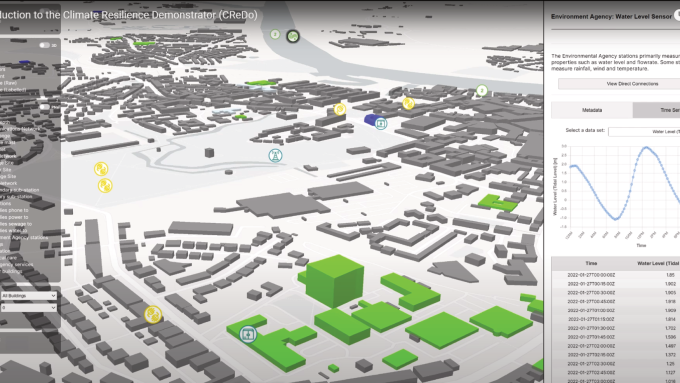‘CReDo is a small step to something potentially huge. It is something tangible that people can see and interact with, taking away the mystique of digital twins’, Matt Webb, Head of Enterprise Data, UK Power Networks
The message coming out of the National Digital Twin programme’s webinar, ‘Increasing our climate resilience through connected digital twins’, is that working together is vital for safeguarding our future. The CReDo project leads the way in showing how collaboration and the sharing of data can dramatically improve our resilience to extreme weather conditions caused by climate change.
Held at the same time as the COP26 climate conference, the webinar on 2 November 2021 launched the Climate Resilience Demonstrator (CReDo) to over 220 attendees from 17 countries and multiple industry sectors. It introduced the CReDo team and collaboration partners and covered the scope of the project, also hosting a panel interview and open Q&A session.
Chaired by Arup’s Global Digital Energy / Digital Twin Leader and Gemini Call Chair, Simon Evans, the event began with the internet premiere of the new CReDo film, a poignant piece about the climate emergency and how it affects us all, especially the most vulnerable. The film offers a view of a world where engineers can make critical decisions based on data from connected digital twins, and improve resilience in a way which makes a difference to people’s lives.
CReDo project lead, Sarah Hayes, reflected on the reality of the film and explained how CReDo is developing a climate change adaptation digital twin looking at the impact of flooding on infrastructure interdependencies across energy, water and telecoms networks. Alongside, Sarah introduced the CReDo app, produced by the Environmental Systems Research Institute (ESRI UK), which invites users to see how connected digital twins can change outcomes for those faced with extreme weather in the fictional town of Sunford City. Sarah explained how the app has been developed to show what a CReDo digital twin can do and that both the film and the app are based on the same fictional storm Ruby, a storm caused by climate change. The app was developed with manufactured data to present a realistic scenario that asset owners could be faced with.
Behind the scenes, the technical team is working with the real data to develop the CReDo digital twin. CReDo Technical Architect, Tom Collingwood summarised the key elements of the project, which bring together climate projection data with flood data, and asset data to calculate system impact to inform a greater understanding of the system effects caused by asset failure. These insights can then be used to inform decisions concerning operational and capital planning to increase resilience across the infrastructure system as a whole. The digital twin demonstrator will show the bigger picture about what can be achieved through knowledge exchange and cross-sectoral cooperation. ‘We’re talking about people, and that’s what matters at the end of the day,’ Tom said, bringing his presentation on the challenges and successes of CReDo’s technical approach to a close.
CReDo project partners, represented by Tom Burgoyne, Anglian Water; Louise Krug, BT; Matt Webb, UK Power Networks; and Tamar Loach, Connected Places Catapult, agree that the ambition relies on close collaboration and a joined-up approach to make it work. Data sharing between networks, enabled using an information management framework, will help us to create resilient infrastructure systems and allow us to adapt to extreme weather events caused by climate change. The active Q&A session underlined the need for the CReDo approach, emphasising the opportunities that joined-up systems and processes can deliver to this sector and others in reducing risk. Robin Pinning from the Hartree Centre, part of the Science and Technology Facilities Council, noted the need for culture change in understanding and in recognising the value of data, along with a drive for investment. One further topic, data security, is also at the forefront of everyone’s minds and CReDo is working towards establishing the framework to cover technical, legal, procedural and security concerns and applying federated access protocols.
‘Data and information are going to be key in mitigating climate change. Bringing that data together in digital twins is going to propel us to enhance resilience,’ Gavin Shaddick, Joint Centre for Excellence in Environmental Intelligence
The expectation is that CReDo will be scalable to other networks, contexts and locations. Gavin spoke live from COP26, having seen at the conference a real understanding that data sharing in order to inform a bigger picture view is an important theme in developing resilience, adaptation and the pathway to Net Zero.
There is no doubt that there will be technical challenges but desire for cross-sector collaboration for data sharing is growing fast. Gavin told the webinar, ‘Work that is going into CReDo on data interoperability and information management is directly transferable and this will make connecting digital twins much easier, both from the technological point of view and the learning in the non-technical aspects including data sharing agreements, how these are formulated and how to involve people in wide interdisciplinary groups’. Robert Pinning supports this view and believes that the project will translate easily to industry and the public sector, acting to speed up adoption of new projects and use cases.
‘There is a need to develop more use cases like CReDo to show the value that can be derived from digital twins,’ Tamar Loach, Technology Initiative Director, Connected Places Catapult.
Ultimately, demonstrating the value will be down to collaborative effort across academia and industry, public and private sectors, within regions and nations, and globally. As this climate resilience project and similar use cases for connected digital twins catalyse action and enable change, then as a society we will be better positioned to adapt and respond to the challenges that face us.
The CReDo team at the National Digital Twin programme would like to thank Simon Evans, the invited panel and the webinar guests for their valuable contributions at this event.


